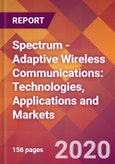Wireless communications are under stress due to the rapid growth of traffic volume and the limited available spectrum. This tendency necessitates rational utilization of these frequencies spectrum, which became the most expensive component in wireless networking. Meanwhile, multiple industry studies show that the available licensed frequency spectrum is extremely underutilized. The relatively low utilization of the licensed spectrum suggests that spectrum scarcity, as perceived today, is largely due to inefficient fixed frequency allocations rather than any physical shortage of spectrum.
The report analyzes modern communications technologies based on Cognitive Radio/Software Defined Radio (CR/SDR) that allow adaptive use of the spectrum in accordance with instantaneous space/time coordinates. The CR technology is heavily dependent upon the SDR technology as a radio needs to be configurable according to the prevailing spectrum environment.
Current technologies for dynamic spectrum access largely rely on database-managed approaches. Standards are also emerging that incorporate cognitive elements, where devices can adapt their operating parameters in conjunction with a centralized database. Autonomous cognitive capabilities through sensing techniques at the device level would, where feasible, offer far greater flexibility for future sharing, These emerging techniques could be used within a number of bands across the radio spectrum to deliver different types of wireless service and could play a role in making more efficient use of spectrum by improving channel throughput within shared operating environments.
Related to CR/SDR standards and markets are subjects of this report research. As an example, one of the first commercial CR/SDR applications - TV White Space (TVWS) communications - is being discussed. A survey of multiple vendors’ portfolios was conducted.
- The CR/SDR technologies, applications, industry and markets analyses have been performed to show the roots of TVWS communications
- TVWS communications origin, properties, regulations, standards and the industry have been analyzed
The report concludes that the development of CR/SDR for WS and particular TVWS communications opens a door to the utilization of previously unused windows of wireless spectrum saving valuable resources and contributing to the growth of the economy.
This report, in particular, provides:
CR/SDR
- An overview of the regulatory climate for CR/SDR in major developed countries
- The analysis of the CR/SDR standardization process
- An overview of CR/SDR technologies specifics
- The analysis of CR/SDR applications, including military, Public Safety Communications, and commercial
- The analysis of market drivers from the perspective of various industries and users groups
- Analyses of CR/SDR global market trends
- Market intelligence on SDR based solutions in the commercial, government, and military industry segments
- Market geographical specifics
- Estimate of major market components
- Information on key suppliers of CR/SDR products and their profiles
TVWS
- Overview of TVWS developmental cycles
- Analysis of the regulatory climate: FCC, Ofcom, other
- Use cases
- Standardization: IEEE, ETSI, ECMA, IETF
- Survey of the industry
- Marketing considerations
Patents Survey - related to the discussed technologies.
Though the focus of the report is public safety applications, the majority of findings relate to a wider spectrum of use cases (communications and localization) in the indoor environments for multiple commercial applications.
The report is written for a wide audience of researchers, engineers and managers that are involved in the development and utilization of cognitive radios and related technologies.
Table of Contents
Companies Mentioned
- 6harmonics
- Adaptrum
- Airbus DS
- AirNet Communications (SDR Base Stations)
- AirSpan (BS)
- ATDI
- Aviacomm
- BAE Systems
- Carlson Wireless
- Carlson Wireless (Platform)
- Datron World Communications (SDR)
- DeepSig
- Digital Receiver Technology (Radio Modules)
- Elbit
- Ericsson (BS)
- Etherstack (Software)
- Ettus Research-NI (Platform)
- General Dynamics (SDR)
- Green Hills (Software)
- Huawei (Platform)
- Intel (Platform)
- KTS Wireless
- L3Harris (SDR)
- Lockheed Martin (SDR)
- Motorola Solutions (BS)
- Nokia (Base Station)
- Northrup Grumman
- Nutaq (DSP and FPGA development solutions)
- Objective Interface Systems (Software)
- Octasic (SDR)
- Redline Communications
- Redline Communications (Platform)
- Rockwell Collins (Radios)
- Saankhya Labs
- Saankhya Labs (Chipset)
- Shared Spectrum Company
- Sinecom
- Spectrum Signal Processing (Platforms)
- Thales (Radio)
- TI (Chips)
- Xilinx (Chips, SDR Development Kit)
Methodology
Considerable research was done using the Internet. Information from various Web sites was studied and analyzed; evaluation of publicly available marketing and technical publications was conducted.
Telephone conversations and interviews were held with industry analysts, technical experts and executives. In addition to these interviews and primary research, secondary sources were used to develop a more complete mosaic of the market landscape, including industry and trade publications, conferences and seminars.
The overriding objective throughout the work has been to provide valid and relevant information. This has led to a continual review and update of the information content.

LOADING...








